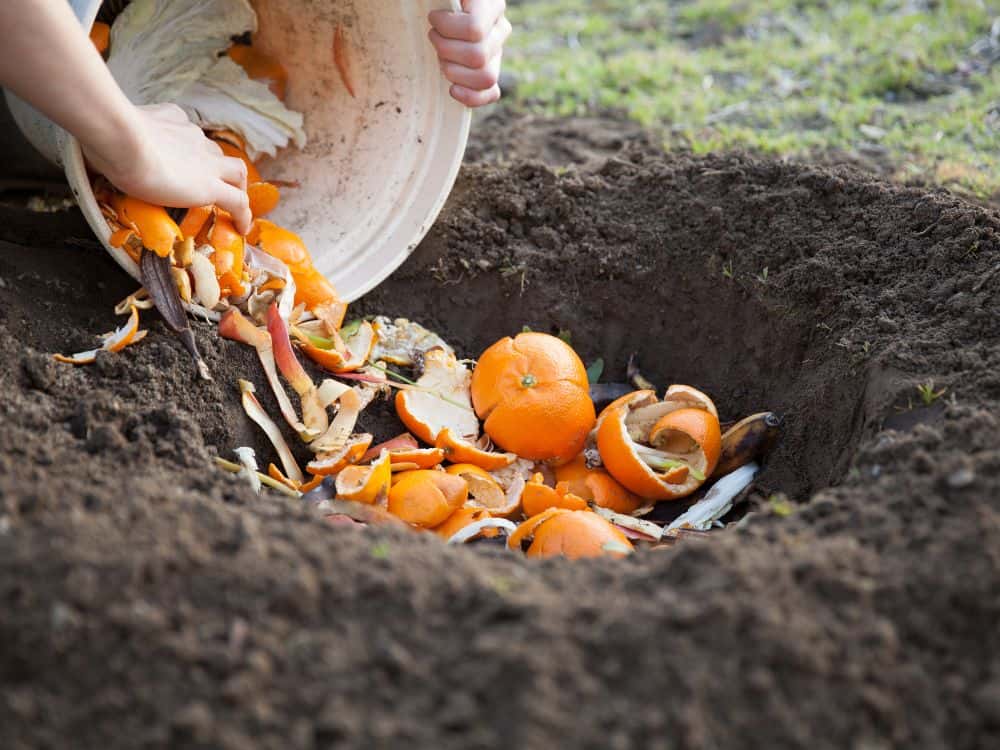
Biodegradable Vs Compostable: A Breakdown Of Breaking Down Waste
It’s a sustainability smackdown!
In one corner of the ring, there’s the reigning champion, biodegradability. He’s old school and dirty, but he’s familiar.
In the other corner, we have compostability, the new kid on the block who’s rapidly rising through the ranks of eco-conscious consumers.
It’s time to settle the score between these eco rivals. Biodegradable vs compostable: which is better?
But before the battle begins, what does compostable mean? And what is the difference between biodegradable and compostable?
Both terms represent the breakdown of matter, but misunderstandings about their fundamental differences cause a lot of problems when it comes to proper disposal.
While “compostable” and “biodegradable” are often used incorrectly and interchangeably, they are quite different. It’s time we, as conscious consumers and zero waste advocates, learn the difference.
Without further ado, let’s watch as compostable vs biodegradable dig into the muck.
The Difference Between Compostable & Biodegradable: Which Is Better?
- What does biodegradable mean?
- What does compostable mean?
- Is biodegradable the same as compostable?
- Compostable and biodegradable standards and certifications
1. What Does Biodegradable Mean?
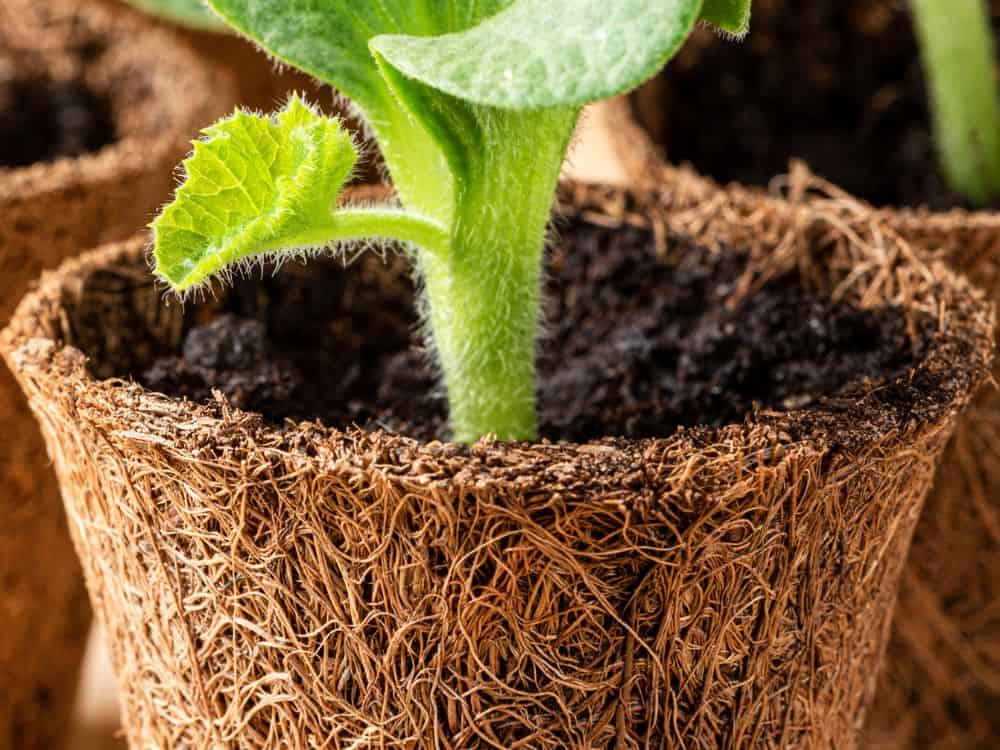
Before we dive into biodegradability, let’s first look at the root of the word: degradable.
Degradable vs biodegradable
Technically, every product on earth is degradable, because it will eventually break down either biologically or chemically.
Biodegradable, meanwhile, is a product that will be broken down by organisms or bacteria.
Traditional petroleum-based plastics and other heavy metal and chemical based materials fall into the category of degradable, but not biodegradable. They never break down fully into their natural elements to be repurposed by the earth; merely into smaller pieces over a long time.
Plastics are the biggest offenders, because they’re either photo-degradable (break down in sunlight) or oxo-biodegradable (now heavily restricted in the EU) into smaller pieces called microplastics.
When it comes to microplastics, these insidious buggers are poisoning every corner of the planet, including fresh snow in Antarctica, and even human lungs, human placenta and human breast milk.
The UN recently declared the scourge of plastics a global crisis.
Breaking down biodegradable materials
At its most basic, for something to biodegrade is for it to break down into its natural elements (water, carbon dioxide, and biomass).
This is the same for solid or liquid waste entering water systems (like natural shampoo or eco-friendlly cleaning products).
This decomposition is accomplished by naturally-occurring microorganisms such as bacteria and fungi in an environment of suitable temperature, moisture, and oxygenation.
Things get tricky when factoring in the time it takes to accomplish this.
The rate at which a material biodegrades (from several months to forever) depends on its environment. Not everything that’s biodegradable breaks down in any location in a reasonable amount of time.
Landfills, for instance, not only slow biodegradation, but also contaminate the process with toxic chemicals. Items biodegrade anaerobically (without oxygen) at landfills, creating huge amounts of not just carbon dioxide, but methane, a GHG 25x more potent than CO2.
Oceans also provide an insufficient environment for biodegradability—despite the fact that trillions of pieces of trash occupy them.
The University of Plymouth’s international marine litter research unit found biodegradable plastic bags were largely undamaged and could still hold considerable weight three years after being left in seawater OR buried.
This is why there is no set certification or universal legal definition of what constitutes a truly biodegradable product. From a consumer standpoint, that means we’re faced with often utterly meaningless labeling.
So what’s all the buzz about biodegradable products?
“Biodegradable” became a buzzword in the 1980s and like many 80s trends (we’re looking at you parachute pants), it should have stayed there.
Especially because biodegradability wasn’t scientifically proven until 2002. That’s two decades of unqualified claims leading people to falsely think they’re being environmentally responsible.
Thankfully, we now have methods to scientifically determine whether something can biodegrade and not leave toxic residue.
Technology has also now made it possible to adapt organic materials to function exactly the same as plastic packaging. We call these bioplastics.
Unlike traditional types of plastic made of petrochemicals, bioplastics are derived from plant-based materials:
- Cellophane: wood (one of the first forms of plastic ever made)
- Polylactic Acid (PLA): vegetable starch
- Plastarch (PSM): plant starch and polypropylene
- Mater-Bi: plant starch
However, being plant-based doesn’t necessarily guarantee a good end-of-life outcome.
Many bioplastics behave the same as regular plastic and take eons to break down.
For the most part, they cannot be recycled, should not go to landfills as their organic makeup will release methane gas, and must only be sent to an industrial composting facility—of which were are only 185 full-scale operations in the US as of 2018.
There are two other key deceptions associated with biodegradable materials:
- FTC regulations technically only mandate that biodegradable products break down, not that they must leave no toxic residue.
- Many companies blend bioplastic with regular plastic, accompanied by the clever caveat of “made WITH biodegradable plastic”. Since they’re not technically calling it biodegradable, the FTC can’t do much.
No wonder environmentalists are increasingly doing away with the term due to copious greenwashing and misapplication. In the state of California, plastic packaging labeled as “biodegradable” is now illegal.
So where does that leave us regarding biodegradable vs compostable plastic?
Remember, one of the most crucial sustainable product criteria is conscious packaging. Ideally, that’s zero waste, meaning it’s naked, reusable, or compostable. Hmm…no mention of biodegradable…
2. What Does Compostable Mean?
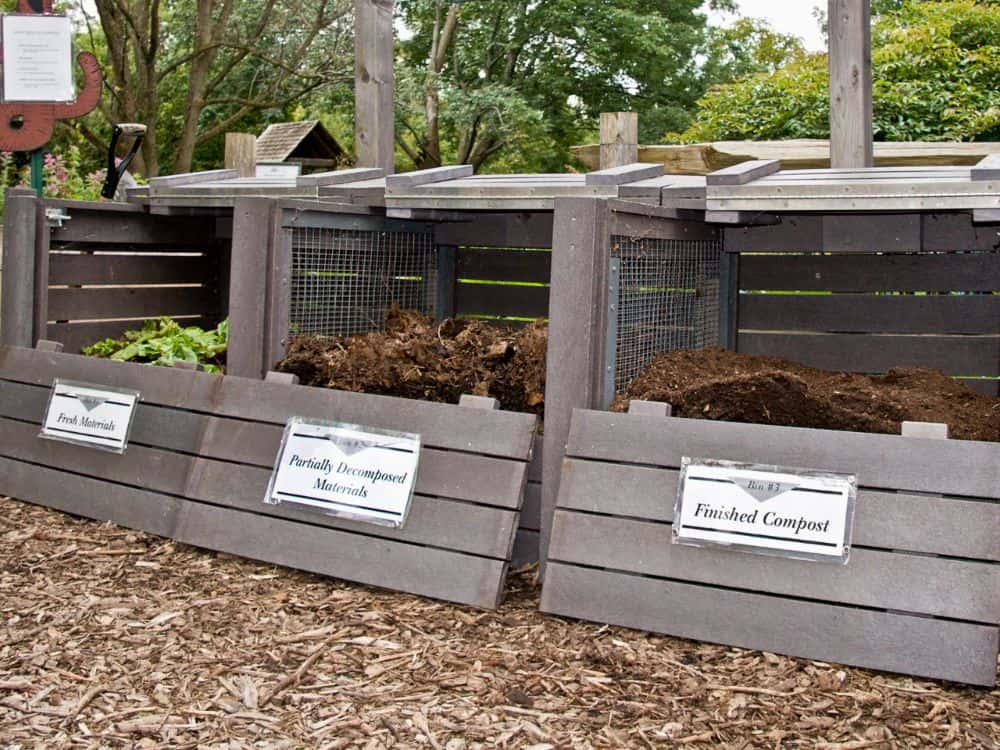
The official definition of compostable is, ”Something that […] can be used as compost when it decays.”
Well, duh, that’s not very helpful.
A more practical compostable meaning is any material that can be recycled back into the completely organic elements in a short (less than 180 days) span of time.
This resulting organic matter is what people call compost, but it’s officially known as humus (no, not to be spread on pita bread).
“But,” you say, “Biodegradable also refers to breaking down into natural elements, so is biodegradable compostable?”
In some respects, yes, biodegradability and compostability share the same foundation.
The composting process aids biodegradation through the balance of moisture, temperature, and oxygenation to optimize microbial action. You can think of compostability as the gold standard of biodegradation.
Compostable products are, by nature, biodegradable, but not all biodegradable products fit the narrower compostable definition.
While biodegradation takes anywhere from months to 10,000 years, composting usually takes place within 12 weeks—resulting in the key difference between compostable and biodegradable.
Composting must also occur directly in soil, a compost heap, indoor compost bins, or commercial composters—not landfills, natural waterways, or oceans.
Unlike general biodegradability standards, compostable items must also break down into completely non-toxic components.
Even natural materials may be rendered non-compostable by additives during manufacturing.
Lumber is a prime example. While wood is 100% organic, building lumber is typically treated with toxic chemicals that leave toxic waste and prevent it from safely decomposing into “usable compost”.
Rules for home compostability
In addition to breaking down into usable compost, FTC guidelines specify home compostable products must do so in “a safe and timely manner”.
A safe timeline to define compostable products is the same as whatever other compostable materials are being composted with it.
Look at compostable vs biodegradable trash bags. A bag that suits all other compostability criteria isn’t compostable if it’s meant to go in a home compost pile with food scraps that biodegrade in half the time.
Home composting definitions are much more limited because a home compost environment does not reach high enough temperatures to break things down quickly
The list of home compostable materials is long, but includes:
- Any non-animal food scraps: fruits, vegetables, peelings, bread, cereal, coffee grounds and filters, crushed eggshells, tea leaves and tea bags (but no staples)
- Leaves, grass, foliage clippings
- Wine
- Dry cat or dog food
- Dust from sweeping and vacuuming
- Old herbs and spices
- Shredded paper or cardboard (must have no coatings, wax, or glue)
Some rules of thumb are to exclude items that may throw off the pH balance, take longer than 6 months to decompose, or release microplastics.
Things that are NOT compostable at home include: bioplastic packaging, biodegradable items, biodegradable bags, compostable bags, compostable food carriers, dryer lint, cat or dog poop, eco-friendly cat litter, fish bones, meat, animal bones, milk, cheese, oils, or butter.
Commercial compost facilities are capable of breaking down these complex products, both due to higher heat and machinery that breaks things down into small pieces.
FTC guidelines mandate that marketing and packaging must qualify where something is designed to be composted and explicitly state if it can’t be home composted.
3. Is 100% Biodegradable The Same As Compostable?
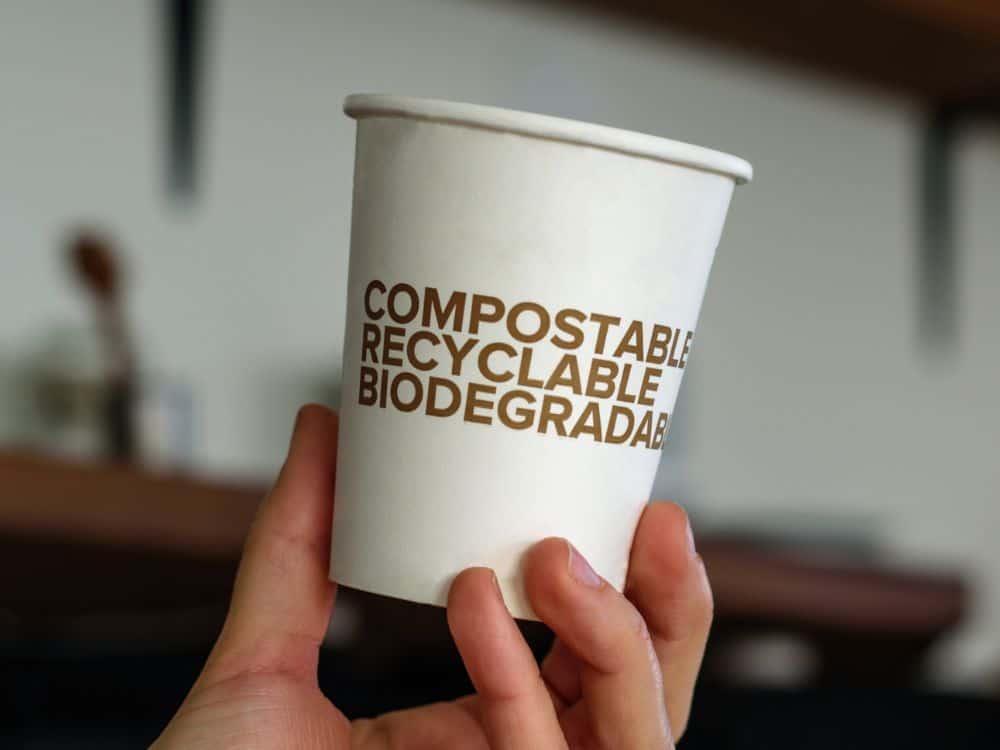
After all that, you may still be wondering, “Does biodegradable mean compostable?”
Or perhaps more practically, “Can I put biodegradable materials in compost ever? And if so, which ones?”
If we’re talking about pure, organic matter, yes, but since the term “biodegradable” is rarely applied to such items, no.
Especially when it comes to biodegradable vs compostable packaging or plastic, there are very different key elements.
These include the speed of decomposition and the requirement to “leave no toxic residue”—which is largely a myth with biodegradable plastics that contribute to our microplastic crisis.
Biodegradable vs compostable plastic bags
There is a “blind embrace” that biodegradable = good, which is why we see biodegradable materials doing more harm in landfills, where they improperly break down, releasing microplastics and methane.
Many bioplastics are not even biodegradable and, though plant-based, “can be designed to be structurally identical to petroleum based plastics”.
Without legal standards for what is labeled as bioplastic or biobased (heck, even 100% petroleum-based plastics can be called biobased!), it’s safe to declare most biodegradable products a fraud.
At least until further research, development, education, and management is addressed, we suggest avoiding single-use biodegradable products altogether.
What about compostable packaging and products?
Unfortunately, compostable plastics are questionable, too, due to current lack of education and infrastructure. In the UK, a whopping 90% of compostable products end up in landfills, and 60% don’t even break down within six months.
Arguments over biodegradable vs compostable garbage bags are pointless if both merely exacerbate waste disposal issues.
Professor Mark Miodownik, co-author of “The Compost Experiment”, writes:
“The bottom line is that home compostable plastics don’t work. Let’s just stop. Let’s not pretend to ourselves that it’s going to be some sort of panacea, and you can sell people stuff without really having the infrastructure to deal with the waste and hope that it’s all going to go away.”
Unless you know your compostable products are standard-approved and going to an industrial facility that will accept that, we suggest avoiding them.
In other words, compostable and biodegradable trash bags are only suitable if they’re being disposed of in the proper way.
If waste is still landfill-bound, use recycled or reused plastic bags instead to prevent methane gas emissions.
If you need a composter in the US, BioCycle’s Find A Composter is a good resource for finding nearby composting facilities. Or use the ShareWaste App to connect to people locally looking for organic waste, but this largely only applies to home compostable waste.
4. Compostable & Biodegradable: Scientific Testing, Legal Standards, & Certifications
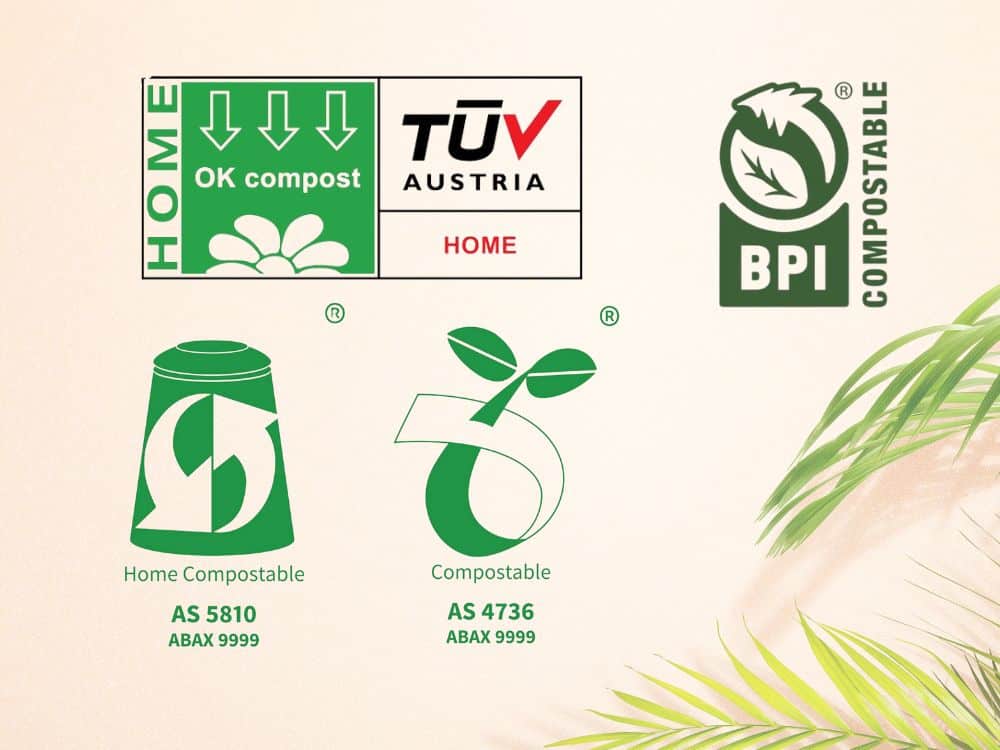
It’s confusing out there in the mulch. It can feel like you need a doctorate in environmental studies just to get your compost properly sorted.
Biobased, bioplastic, degradable, biodegradable, and compostable are not the same and with few legally binding global statutes, there’s very little accountability behind these words depending on where in the world you are.
U.S. and Canada:
The Federal Trade Commission (FTC) has some enforceable laws around labeling to prevent greenwashing and a handy guide on environmental marketing claims.
FTC guidelines include:
- Biodegradability: The entire product or package must “completely break down and return to nature within a reasonably short period of time [one year] after customary disposal,” as indicated by reliable scientific evidence.
- Compostability: The item breaks down in equal time with the other compost, or 180 days maximum.
While making false biodegradability claims is unlawful, it’s important to understand being in compliance with FTC guidelines is not the same as being certified.
For certifications, there are two relevant bodies:
- USDA BioPreferred: While the closest thing the US has to a biodegradability certification, the USDA Biobased label is NOT a certificate of complete biodegradability. Though the minimum biobased content required varies across categories, the baseline is a mere 25%.
- Biodegradable Products Institute: The most reputable certifier of commercially compostable products only (not home). They also no longer certify biodegradable products. To avoid confusion, see their labeling guidelines or their searchable database to double-check a brand’s “certified” claims.
Both certify products based on standards set by ASTM International (formerly American Society of Testing and Materials). These lab-tested precedents ensure a product fully breaks down within the allotted permissible time—180 days or fewer for compostable and under one year for biodegradable.
There are three ASTM compostability standards:
- ASTM D6400: The baseline test for compostability for plastics designed to be composted in municipal or industrial aerobic composting facilities. To pass, the material must biodegrade “at a rate comparable to known compostable materials” and produce usable compost undiminished in quality.
- ASTM D6868: Identical to above but for paper materials coated with a bioplastic film (i.e. paper coffee cups with a water-resistant PLA laminate). This certification ensures ALL parts will compost in municipal facilities.
- ASTM D6866: A radiocarbon analysis to determine a material’s bio-base carbon to its “fossil carbon” (derived from fossil fuels). Lots of dense science in this one, but essentially, the presence of carbon 14 indicates a material will break into biomass rather than fossil fuels.
It’s important to understand that none of these ASTM standards currently certify home compostability, so any company that claims their products are home compostable based on these standards (as some do) is outright lying.
ASTM is supposedly developing a standard for home composting, but no news has been published on this front since 2015.
In summary for the US and Canada: ASTM International sets definitions and standards, BPI provides the third party certification of the standard being upheld, and the FTC enforces against false or deceptive product labeling.
Europe:
The EU has no certification for biodegradability, but two standard measures of compostability:
- EN 13432: Standards for compostable packaging plastics alone, in order to completely degrade in an industrial composting plant.
- EN 14995: An expansion of the former for plastics used outside product packaging.
Both standards specify microbial action rate (90% biodegradation in 6 months), end fragment size, ecotoxicity, and chemical analysis (environmentall harmless compounds and additives no more than 1%).
Then, one of two third-party agencies will certify a product meeting EN standards:
- TUV Austria: Offer a number of different stamps, like OK compost INDUSTRIAL or OK compost HOME, for respective industrially or home compostable materials.
- DIN Certco: Also have a stamp for industrial compost and a stamp for home and garden compost.
But here’s the dirt: the standards are not legally binding in Europe and there is no obligation to disclose exactly how much bio-based material is in a product.
Australia & New Zealand:
They have two standards via Australasian Bioplastics, one for industrial compost of biodegradable material, and one for home composting:
- AS 4736-2006: The general standard of a plastic being commercially compostable and biodegradable.
- AS 5810-2010: The verification for any items (including plastics) that can be composted at home. It requires disintegration in six months and full biodegradation in a year.
Did you know we Have a Newsletter?
We cover the latest in sustainable living, fashion, zero waste, beauty, travel, finance and more…
Final Thoughts On Biodegradability & Compostability
In summary: does compostable mean biodegradable?
No, and we recommend you ditch the murky biodegradable labels and opt for organic, compostable products.
Though, when it comes to biodegradable and compostable plastics and bags, both fall short of the needed answer to our single-use addiction.
The most important thing is to refuse and reduce where you can and reuse where you can’t. And if you do opt for these products, only do so if you know you have the means to properly dispose of them.
Understanding the nuances of compostable vs biodegradable vs recyclable is critical if we want to be more conscious consumers because we should always buy things knowing what we’ll do with them when they’re no longer functional.
So read labels with a healthy dose of skepticism, look for the certifications, and pass this article along so more people can better understand the important distinctions when it comes to biodegradable and compostable products.
Pin these:
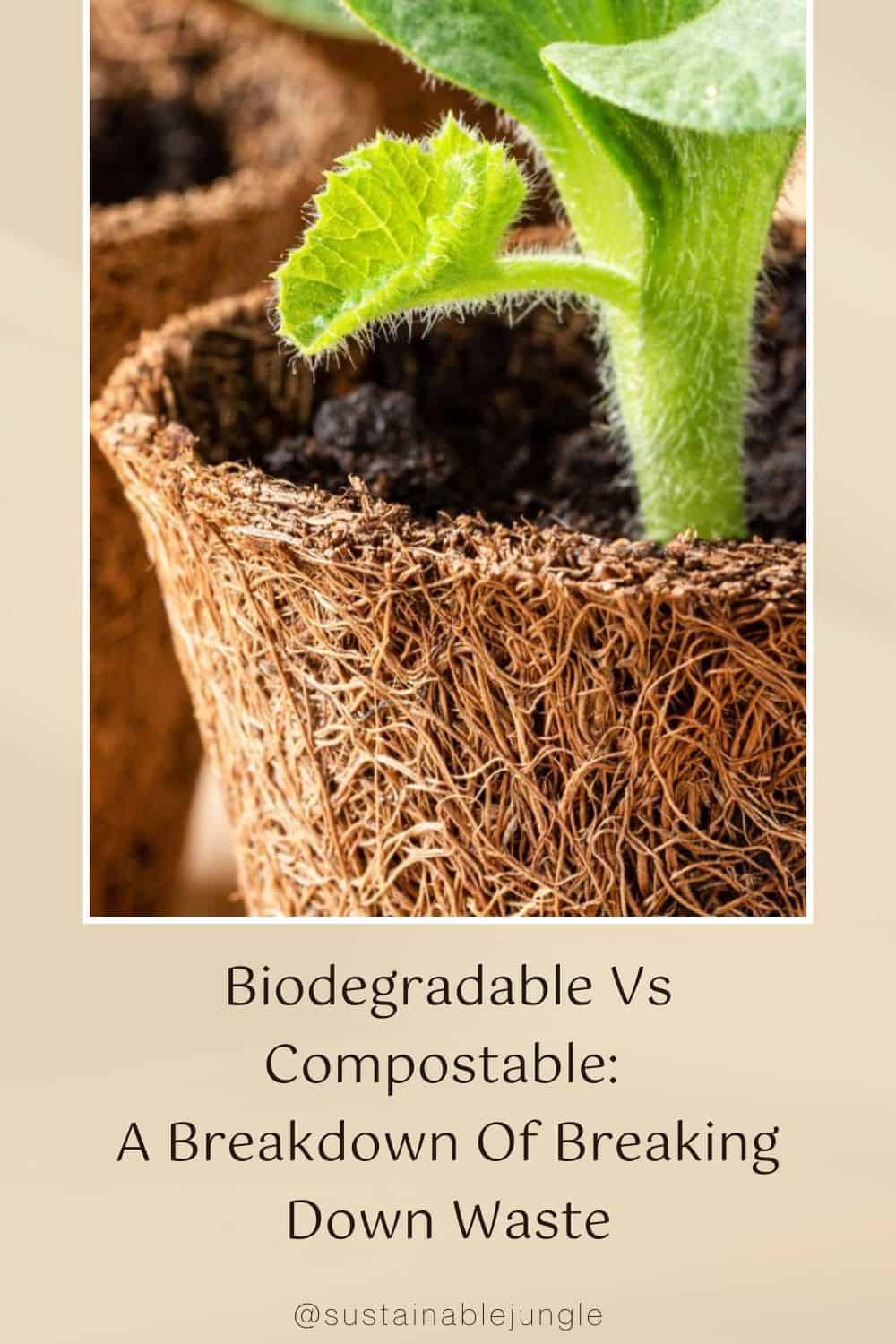
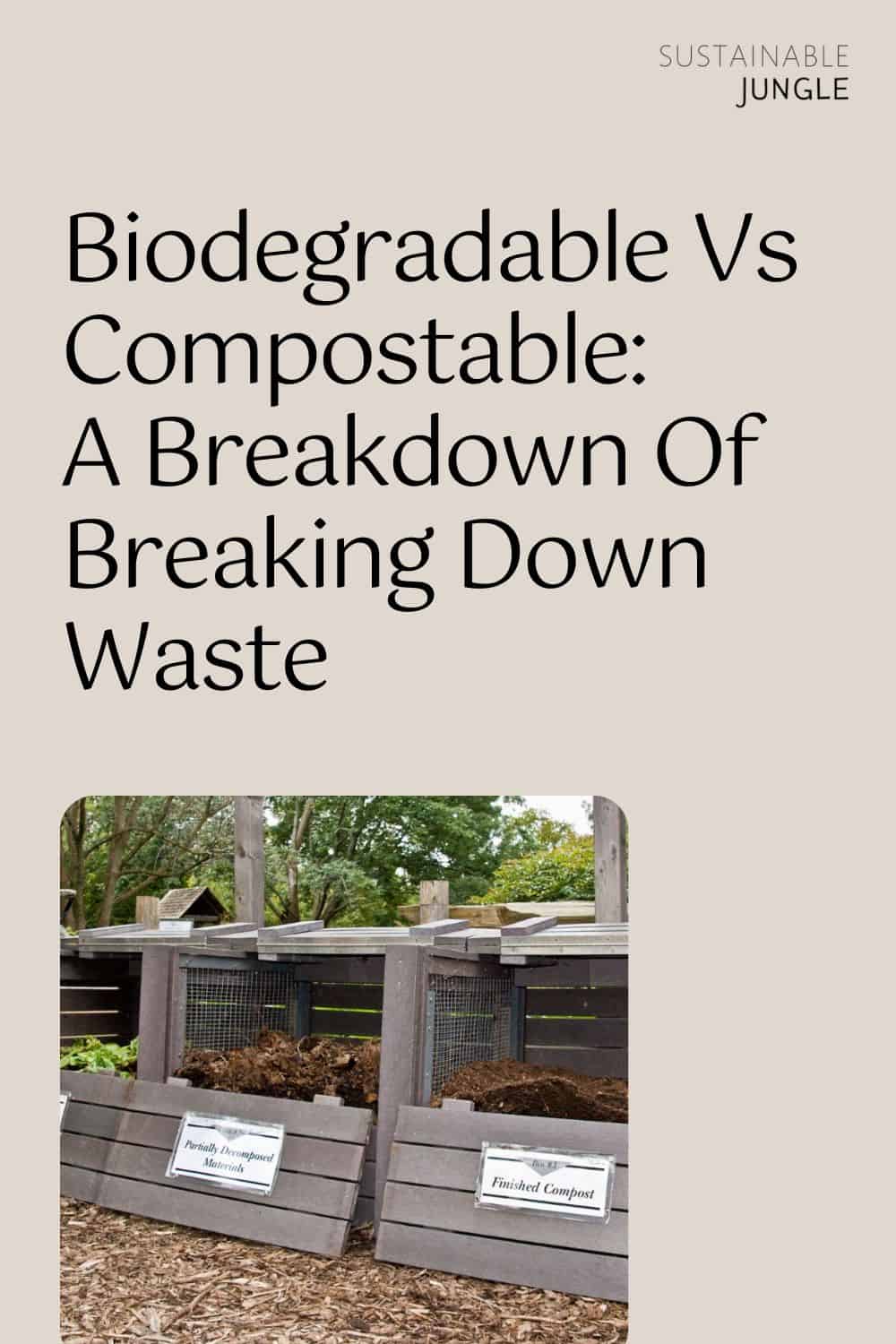

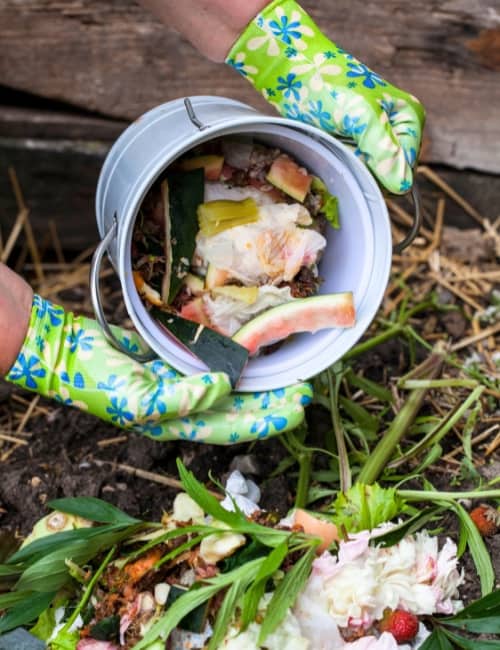
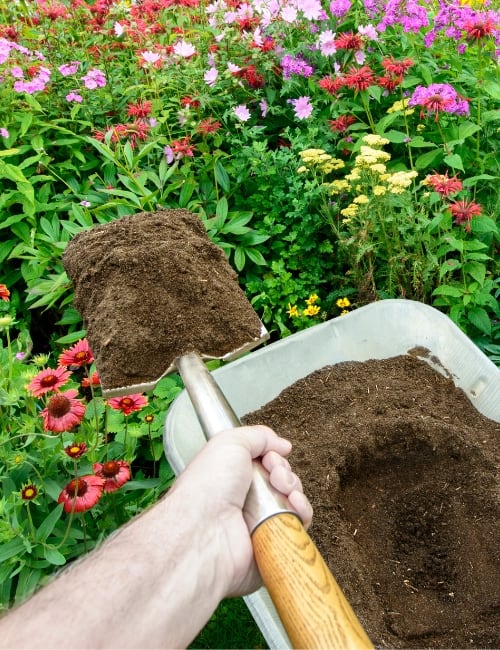
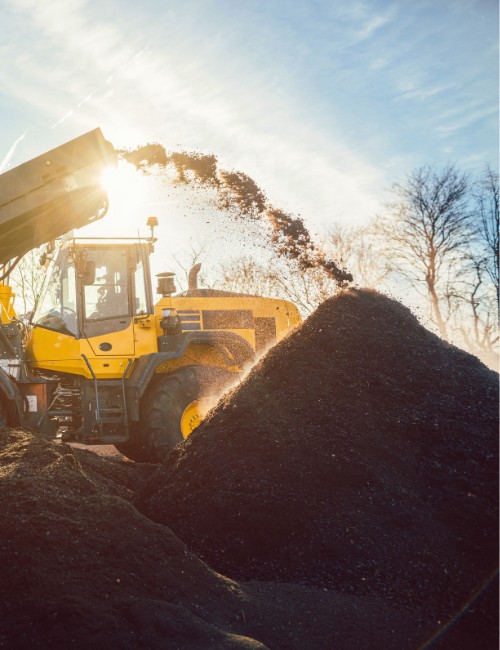
Hello!! Really nice article…. I am wondering two things.
One, what happen if a compostable product (not for home composting) goes to the landfill?, still is better?
Two, what about the living materials? do you know something about them?
Not the author – but my understanding is that it’s actually worse if a compostable product ends up in the landfill – as it emits methane rather than CO2, which is worse for the environment. I *think* it’s better to purchase 100% recycled items vs compostable in those situations.